
The Union Jack or Union Flag is the de facto national flag of the United Kingdom. The Union Flag was also used as the official flag of several British colonies and dominions before they adopted their own national flags. The flag continues to have official status in Canada, by parliamentary resolution, where it is known as the Royal Union Flag.

The flag of England is the national flag of England, a constituent country of the United Kingdom. It is derived from Saint George's Cross. The association of the red cross as an emblem of England can be traced back to the Late Middle Ages when it was gradually, increasingly, used alongside the Royal Banner. It became the only saint's flag permitted to be flown in public as part of the English Reformation and at a similar time became the pre-eminent maritime flag referred to as a white ensign. It was used as a component in the design of the Union Jack in 1606.

The flag of Quebec, called the Fleurdelisé, represents the Canadian province of Quebec. It consists of a white cross on a blue background, with four white fleurs-de-lis.

The Red Ensign or "Red Duster" is the civil ensign of the United Kingdom of Great Britain and Northern Ireland. It is one of the British ensigns, and it is used either plain or defaced with either a badge or a charge, mostly in the right half.

In British maritime law and custom, an ensign is the identifying flag flown to designate a British ship, either military or civilian. Such flags display the United Kingdom Union Flag in the canton, with either a red, white or blue field, dependent on whether the vessel is civilian, naval, or in a special category. These are known as the red, white, and blue ensigns respectively.

The flag of New Zealand, also known as the New Zealand Ensign, is based on the British maritime Blue Ensign – a blue field with the Union Jack in the canton or upper hoist corner – augmented or defaced with four red stars centred within four white stars, representing the Southern Cross constellation.
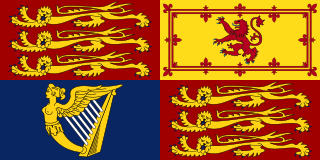
The royal standards of the United Kingdom presently refer to either of two similar flags used by King Charles III in his capacity as sovereign of the United Kingdom, the Crown dependencies, and the British Overseas Territories. Two versions of the flag exist, one for use within Scotland and the other for use elsewhere.
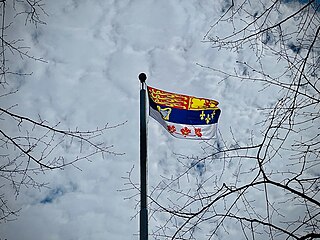
The royal standards of Canada are a set of personal flags used by members of the Canadian royal family to denote the presence of the bearer within any vehicle, building, or area within Canada or when representing Canada abroad. All are based on a banner of the coat of arms of Canada, which are the arms of the Canadian monarch.

The coat of arms of New Zealand is the heraldic symbol representing the South Pacific island country of New Zealand. Its design reflects New Zealand's history as a bicultural nation, with a European female figure on one side and a Māori rangatira (chief) on the other. The symbols on the central shield represent New Zealand's trade, agriculture and industry, and a Crown represents New Zealand's status as a constitutional monarchy.

Elizabeth II was the only queen of the State of Malta, which existed from 1964 to 1974. The State of Malta was an independent sovereign state and a constitutional monarchy, which shared a monarch with other Commonwealth realms, including the United Kingdom. Elizabeth's constitutional roles in Malta were mostly delegated to a governor-general.

The Queen's Personal Australian Flag was the flag of Elizabeth II in her role as Queen of Australia. It was used in a similar way as the Royal Standard in the UK, by signalling the monarch's presence within a building or vehicle in Australia.
The island nation of Malta has a variety of national flags and symbols, some current and some no longer in use.

The flag of the governor-general of New Zealand is an official flag of New Zealand and is flown continuously on buildings and other locations when a governor-general is present. The flag in its present form was adopted in 2008 and is a blue field with the shield of the New Zealand coat of arms royally crowned. The official heraldic description is "A flag of a blue field thereon the Arms of New Zealand ensigned by the Royal Crown all proper".
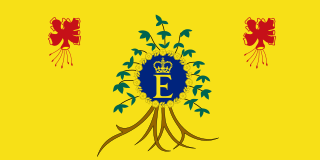
The Queen's Personal Barbadian Flag was the personal standard of Queen Elizabeth II, in her role as Queen of Barbados for use while in Barbados. It was first used when the Queen visited Barbados in 1975. The Queen's representative, the Governor-General of Barbados, had their own standard.

The Star of India refers to a group of flags used during the period of the British Raj in the Indian subcontinent. India had a range of flags for different purposes during its existence. The Princely states had their own flags which were to be flown alongside the British flag as a symbol of suzerainty. The official state flag for use on land was the Union Flag of the United Kingdom and it was this flag that was lowered on Independence Day in 1947. The flag of the governor-general of India was defaced with the Star of India. The civil ensign and naval ensign were the Red Ensign or Blue Ensign, respectively, defaced with the Star of India emblem.
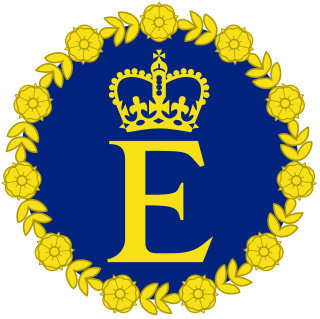
Queen Elizabeth II had a variety of flags to represent her personally and as head of state of several independent nations around the world. They were usually used on any building, ship, car, or aircraft where she was present.

Elizabeth II was Queen of Mauritius as well as its head of state from 1968 to 1992 when Mauritius was an independent sovereign state and a constitutional monarchy within the Commonwealth of Nations. She was also the monarch of other Commonwealth realms, including the United Kingdom. Her constitutional roles in Mauritius were delegated to a governor-general. Mauritius became a republic in 1992.
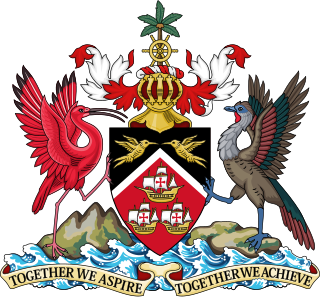
Elizabeth II was Queen of Trinidad and Tobago from the independence of Trinidad and Tobago on 31 August 1962 until the country became a republic on 1 August 1976. Her constitutional role as head of state was delegated to a governor-general, who acted on the advice of government ministers.

Elizabeth II was Queen of Sierra Leone from 1961 to 1971, when Sierra Leone was an independent constitutional monarchy. She was also the monarch of other Commonwealth realms, including the United Kingdom. Her constitutional roles in Sierra Leone were mostly delegated to the governor-general of Sierra Leone.
The three branches of the Australian Defence Force are each represented by flags, among other emblems and insignia. Within each service, various symbols fly on individual ships, at bases, camps, the Australian Defence Force Academy and colleges. These include flags, standards, guidons and banners and that denote rank, appointment, corps, formations, regiments, training units and sub-units.





















